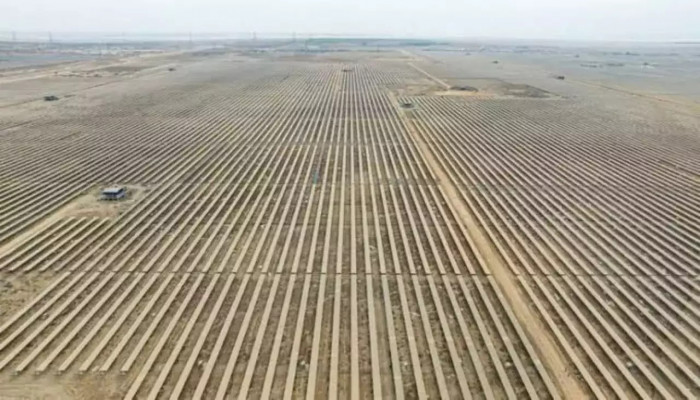India unveils world’s largest renewable energy park in Gujarat
- In Reports
- 10:30 PM, Apr 12, 2024
- Myind Staff
In a remote region near the Pakistan border, Gautam Adani's conglomerate has constructed the largest renewable energy park globally in Gujarat's Khavda area. With an impressive capacity of 45 gigawatts, this park primarily harnesses solar energy for electricity generation. Initially, the region lacked essential infrastructure, with only a portable toilet and a makeshift office in a container. However, Gautam Adani, who was the world's second richest individual at the time in December 2022, saw promise in this barren land despite its lack of basic amenities like a postal code.
Originally, the land was desolate, characterized by sparse vegetation owing to its saline soil and absence of nearby human settlements. Nonetheless, it possessed favourable conditions for renewable energy development, featuring the country's second-highest solar radiation levels after Ladakh and wind speeds five times higher than those on the plains. Situated just an 18-kilometer drive from the airstrip, the Khavda renewable energy park covers an expansive 538 square kilometers, approximately five times the size of Paris.
Upon landing at Khavda, Gautam Adani was astounded, joking about the absence of mosquitoes in such desolate surroundings. Nevertheless, his group embarked on a remarkable transformation project. Solar panels were installed to convert sunlight into electricity, while windmills were erected to harness wind speeds reaching up to 8 meters per second. Worker colonies were constructed, and desalination plants were established to make saline groundwater sourced from depths of 700 meters, potable. Essential services such as mobile phone repair shops were also set up, turning the once barren wasteland into a bustling centre of renewable energy production and sustainable living.
Adani Green Energy Ltd, India's leading renewable energy company, plans to invest approximately Rs 1.5 lakh crore to generate 30 megawatts of clean electricity in Khavda, Gujarat's Kutch region, according to its Managing Director, Vneet Jaain. He stated, "We have recently commissioned 2,000 MW (2 GW) of capacity at Khavda and aim to add 4 GW in the current fiscal year, with an additional 5 GW planned annually thereafter."
The airstrip serves to transport group executives from Mundra or Ahmedabad a few times per week. The air traffic control (ATC) at Bhuj, located approximately 160 kilometers away, serves as the final guidance point for airplanes heading to Khavda. However, its jurisdiction extends only to 'Tent City,' leaving pilots virtually on their own for the remaining 80 kilometers or so, including landing. A pilot flying the Adani Group-owned plane explained, "We rely on visual aids and the airplanes' navigation systems for landing. When taking off, we communicate our plans to Bhuj over the phone."
The energy park's outer boundary lies just one kilometer from the international border with Pakistan, with the buffer zone manned by the Border Security Force (BSF). Remarkably, the airstrip was constructed in a mere 35 days, in an area where even tractors had to be adapted to navigate the land, which struggles to absorb water. The region presents its own unique set of challenges, including frequent heavy dust storms from March to June, a lack of communication and transport infrastructure, the nearest habitable area being 80 kilometers away, soil that doesn't retain water during the rainy season, saline groundwater, and its designation as a restricted zone.
Despite these hurdles, the Adani Group is making significant progress. While some workers are sourced from the nearby Khavda village, accommodations are being developed to house up to 8,000 workers. Adani's renewable energy initiatives are among the most ambitious in the country, aiming to generate 500 gigawatts of electricity from non-fossil sources by 2030, as part of a broader strategy to achieve net-zero emissions by 2070.
At its peak, the Khavda region is projected to generate an astonishing 81 billion units of power, which is ample to supply entire nations such as Belgium, Chile, and Switzerland. Vneet Jaain outlined that the planned 30 gigawatts (GW) of capacity at Khavda will consist of 26 GW of solar and 4 GW of wind power. AGEL's current operational portfolio includes 7,393 megawatts (MW) of solar capacity, 1,401 MW of wind capacity, and 2,140 MW of wind-solar hybrid capacity.
Despite the impressive solar irradiation of 2,060 kWh/m2 and excellent wind resources in the Khavda region, the frequent sandstorms necessitate regular cleaning of solar panels, sometimes multiple times per day. To tackle this challenge, executives have unveiled plans to deploy waterless robotic module cleaning systems throughout the project site.
It's noteworthy that the land in Khavda is government-owned and has been leased to the Adani Group for a period of 40 years.
Over the past five years, Adani Green has undertaken an exhaustive series of studies and assessments before embarking on development at the site. These included geotechnical investigations, seismic studies, and thorough resource assessments, alongside comprehensive environmental and social impact assessments and detailed feasibility studies.
Construction kicked off in 2022, marking the initiation of a comprehensive infrastructure development endeavour. This included the construction of 100 kilometers of roads and 50 kilometers of drainage systems. Furthermore, desalination plants and three reverse osmosis (RO) plants were established, boasting a combined capacity of 70 cubic meters per hour to meet the drinking water needs of project staff. Additionally, optical fibre cables were laid across 180 kilometers to enhance connectivity, and concrete batching plants were set up as part of the project's infrastructure.
Image Source: The Economics Times







Comments